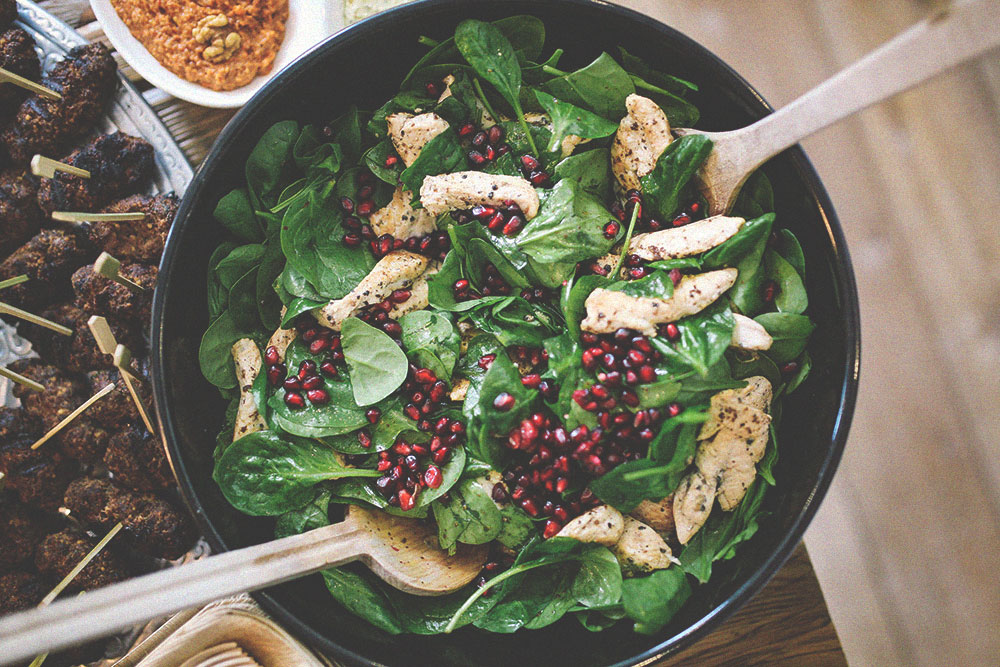What better way to celebrate fresh, light, and vibrant vegetables than with a salad? Before you break out the store-bought bottle, let’s break down the most basic steps to dress it up.
BY: LINDSEY KANE, MS, RD, LDN
While salads are probably one of the healthiest meals of all, how we dress our salad can totally make or break the best of intentions. In fact, store bought dressings can oftentimes be what I call the “undo” button, capable of completely sabotaging what could have been a delicious and nourishing meal.
Don’t believe me? Head to your fridge or pantry, pick up a store-bought dressing and take a glance at the list of ingredients. More times than not, you will find a long list of highly processed ingredients, including sneaky sugar, excess sodium, and highly refined oils, along with an assortment of artificial additives and preservatives.
So, how do we dress our salads for success? You can start by learning what to look for when reading the nutrition label of store-bought salad dressing. But the truth is, you’re better off making your own. DIY Dressing is a no brain-er – it’s healthier, more affordable, and puts you back in the driver’s seat.
The idea of making your own salad dressing may feel intimidating, but after a little practice, it becomes second nature. To make it extra simple, here’s a 5-step guide to DIY salad dressings:
1. Fat
Fat serves many purposes! It brings a creamy texture to your salad dressing and serves as an emulsifier that holds all the other ingredients together. Fat also acts as a chauffeur for your salad’s nutrients. Did you know that many of our nutrients are “fat soluble”? That means they need fat to help transport them from our GI tract to our cells. Without fat, our nutrients never reach our cells and we lose out on reaping their health benefits. This is why fat-free salad dressings are actually counterproductive. Try one of these high-quality fats: Olive oil, flax oil, nut and seed butters like tahini or almond butter, organic yogurt, hummus, or a mashed up avocado.
2. Acid
Acid brightens up your salad dressing, bringing a nice tang to every bite. Think: vinegars and citrus fruits. There are so many different vinegars to explore: red wine, white wine, apple cider, sherry, balsamic, white balsamic, rice vinegar – each of these has a unique flavor. You can also use lemons, limes, oranges, and grapefruits .
3. Seasonings
Here’s where you get to add some personality to your dressing. Add garlic, some minced onions, scallions, or shallots, or mix it up with ginger or different herbs and spices. Think of what kind of flavor profile you’re craving — whether it’s Asian, Mexican, Italian, Mediterranean — and let that direct you towards seasoning combinations commonly used in these areas of the world. For example, if you’re going for an Asian-style dressing, you’ll probably add some grated ginger and garlic and perhaps some cilantro or fresh mint and toasted sesame oil. Pro Tip: Use Chef Chad Sarno’s Herb & Spice Chart as a guide to creating flavor combination from around the globe!
4. Salt
In cooking, we add salt to bring out the flavor of the other ingredients, not to mask the ingredients. Add a pinch of sea salt, or a splash of tamari, or whisk in a little bit of miso paste. Chopped or pureed olives or capers are also a fun way to add a briney, salty bite.
5. Sweet
A touch of sweetness helps round out the ingredients in a dressing, sauce, or dish. I generally encourage tasting your dressing before sweetening – you may find it tastes great as is! If you do find a need for a sweetener, it’s best to choose something that also delivers nutrients. Think: Fruits — fresh, frozen, dried, or pureed — or a splash of 100% fruit juice. You can even add grated or pureed veggies that tend to have a natural sweetness, like sweet potatoes, beets, carrots, or roasted garlic, sun-dried tomatoes, and caramelized onions. A teaspoon of honey or pure maple syrup is also a great option. Whatever you choose, be mindful and sweeten sparingly. This is a case of “less is more.”
Once you have all of the components, it’s time to mix it all up!
Traditional salad dressings are usually one part vinegar to three parts oil, but feel free to play around and discover your personal preference. If you enjoy tangy dressings, use a higher acid to oil ratio. Others may prefer more subtle notes of acidity, so using a higher fat ratio, or even simply adding some water, can help dilute or mute the acidity in a dressing.
And don’t forget, your DIY dressings aren’t just great for salads! They also work well as marinades or finishing sauces for proteins, roasted veggies, and Buddha bowls. So if you aren’t a salad lover, learning a few DIY dressing recipes to keep in your back pocket will still be worth the investment.
For more salad dressing tips, read the full article.
HEADER IMAGE: KAROLINA GRABOWSKA
Lindsey Kane, MS, RD, LDN is a San Francisco-based Registered Dietitian helping others live a stress-free, balanced, and thriving life. By getting to know her clients inside and out, Lindsey identifies the opportunities within their everyday lifestyle to integrate subtle changes that create lasting, impactful results. Learn more at Bite For Change!

